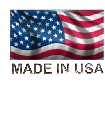|
Surface Finishes |
|
Standard indoor crane systems are cleaned of rust and grease and then finished with primer and enamel paint. Systems designed for outdoor and/or in extreme environments require more durable surface finishes such as standard epoxy, marine epoxy or a finish specified for a particular environment. |
|
Radio Remote Controls |
|
In many situations, pendant pushbutton stations are not the optimal control solution for the operator. For example, if the load is bulky and the operator must stand further away from the crane in order to see clearances properly, or if the awkward weight distribution of the load dictates standing further away for safety reasons, radio remote controls are preferred to ‘pendants’. Radio frequency technology has improved to the point where there are very few environments where there is risk of interference with other radio wave- We understand that many customers already own and want to standardize on a certain brand/model of radio remote control, so we provide radio remotes from a broad array of suppliers, including: We are able to provide radio remote controls from other vendors as well; if you don’t see your preferred brand on the list above, just ask us and we’ll be sure to include it in our quotation. |
|
NEMA Packages |
|
The National Electrical Manufacturers Association (NEMA) rates different types of electrical enclosures according to their ability to keep out dust, liquids, corrosive agents and other foreign matter. Based on your application and environment, we will recommend a particular package of NEMA electrical enclosures to protect your crane system from damage or premature wear. Some examples:
|
Travel Limit Switches |
|
Travel limit switches prevent the hoist, trolley and end trucks from traveling too far in a direction, which could cause damage to the crane equipment, the load and/or the building. Although physical barriers such as bumpers can also provide protection against some of these hazards, limit switches are preferred because they can be reset easily for different limits and because they provide a ‘softer’ stop than a bumper can.
Aside from helping to avoid damage to the crane equipment, the load and the building, limit switches provide important safety protections for your employees, because they prevent:
|
Anti- |
|
Anti- |
|
Secondary Brakes |
|
Most hoists commercially available today employ electro- |
|
Guide Rollers |
|
You may want to purchase new crane equipment to be used on an existing runway structure in your facility. Problems can arise, however, if your existing runway is not straight and level. If we are aware of the condition prior to designing the crane equipment, we may be able to accommodate runways that are ‘less- |
|
Special Packages |
|
In our nearly five decades of experience, we have become very familiar with a multitude of industries and know that certain industries or environments have particular needs. We take pride in our ability to anticipate your needs and hope you view our decades of broad experience in many industries and sectors as another reason why you choose to work with us. Picking up on the examples above (in the NEMA Packages section):
|
|
|
||
|
|
||
|
|
||
|
|
||
|
|

Products |
Services |
Learning Center |
Industries |
Contact Us |
|
|
||||
|
Case Studies |
Aircraft Hangars |
|
||
|
Crane Glossary |
|
|||
|
NAI In The News |
|
|||
|
|
|
|||
|
|
|
|
||
|
|
|
|
|
|
|
|
|
|
|
|
|
© NAI Cranes, LLC 2008- |
|
|||









